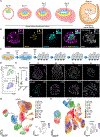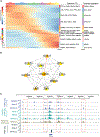Human Primordial Germ Cells Are Specified from Lineage-Primed Progenitors
- PMID: 31875561
- PMCID: PMC6939677
- DOI: 10.1016/j.celrep.2019.11.083
Human Primordial Germ Cells Are Specified from Lineage-Primed Progenitors
Abstract
In vitro gametogenesis is the process of making germline cells from human pluripotent stem cells. The foundation of this model is the quality of the first progenitors called primordial germ cells (PGCs), which in vivo are specified during the peri-implantation window of human development. Here, we show that human PGC (hPGC) specification begins at day 12 post-fertilization. Using single-cell RNA sequencing of hPGC-like cells (hPGCLCs) differentiated from pluripotent stem cells, we discovered that hPGCLC specification involves resetting pluripotency toward a transitional state with shared characteristics between naive and primed pluripotency, followed by differentiation into lineage-primed TFAP2A+ progenitors. Applying the germline trajectory to TFAP2C mutants reveals that TFAP2C functions in the TFAP2A+ progenitors upstream of PRDM1 to regulate the expression of SOX17. This serves to protect hPGCLCs from crossing the Weismann's barrier to adopt somatic cell fates and, therefore, is an essential mechanism for successfully initiating in vitro gametogenesis.
Keywords: TFAP2A; TFAP2C; germ cells; pluripotency; single cell RNA-sequencing; stem cells.
Copyright © 2019 The Author(s). Published by Elsevier Inc. All rights reserved.
Conflict of interest statement
DECLARATION OF INTERESTS
The authors declare no competing interests.
Figures







References
-
- Deglincerti A, Croft GF, Pietila LN, Zernicka-Goetz M, Siggia ED, and Brivanlou AH (2016). Self-organization of the in vitro attached human embryo. Nature 533, 251–254. - PubMed
Publication types
MeSH terms
Substances
Grants and funding
LinkOut - more resources
Full Text Sources
Other Literature Sources
Medical
Molecular Biology Databases

